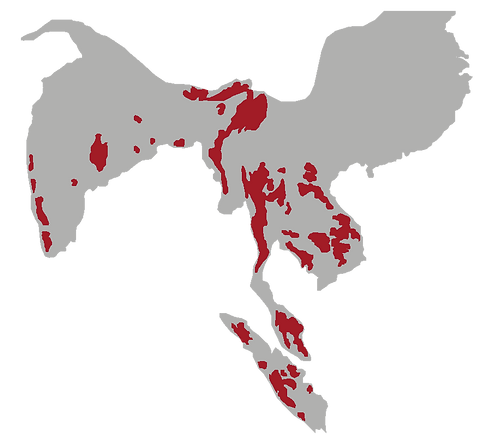WILD TIGER
ENDANGERED
3,900
left in the wild
Height : 70 - 120 cm
Weight : 99 - 299 kg

Habitat : Asia

Wild tigers are the largest of all Asian big cats. They are solitary animals who like to have their own individual territory, with the size depending on the prey available. They mark their territory with urine, feces, scratches and scrapes or by using their vocals to warn other intruders off. They typically hunt alone and stalk their prey waiting for the perfect moment to pounce, eating up to 80 pounds of meat at one time. They can sprint up to 60kph and jump up to 10 feet making them excellent hunters with their 4 inches claws that help them to grab onto their prey and hold them down. They also love to swim and play in the water. Female tigers reach sexual maturity at 3 or 4 years of age and a male a little later at 4 or 5. They average 2 to 4 cubs every year but could have up to 7 cubs a litter. When the cubs are born they are born blind and helpless and around half of all cubs won't live beyond the age of 2. The mother must leave her cubs to go and hunt, leaving the babies alone and vulnerable. At just 8 weeks old the cubs are ready to start hunting and will go on hunting expeditions with their mother until they reach 2 years old at which point they will leave to live their solitary life. The mother may then have another litter but if all the cubs die in one litter the mother can have another litter within 5 months. A tiger can mate with any other big cat and have been known to mate with lions. If a male tiger impregnates a female lion they have a hybrid born animal known as a Tigon and if a male lion mates with a female tiger they have a Liger. There are currently more tigers in captivity than there are in the wild. Wild tiger numbers have been declining for a century and due to the threats that they face.
THREATS

Lack of Food
With the loss of habitat that tigers face and the effects of climate change posing more risks to all animals the natural order of wildlife is being disturbed. There is significantly less prey for tigers to find and hunt and with the threat of human conflicts tigers struggle to find food causing the reduction of the tiger population.
Human Impact

Humans are the reason for the deforestation that tigers face. As the tigers territory has decreased over the years they have been forced to leave their protected areas to search for new territory with food which takes them into human dominated areas where they will hunt livestock. In retaliation tigers are killed or captured, sometimes ending up on the black market.

Loss of Habitat
As human population expands and grows so does the space that humans need. This leads to more agriculture, settlements and roads being built which in turn takes away the space from other mammals. Tigers have lost around 95% of their historical range. Tigers are territorial and need large living spaces with enough water and food to survive on, few tigers can survive in scattered islands of habitat.

Poaching
Tigers in the wild are being killed illegally to fuel the illegal trade of tiger skins, bones, meat, claws and teeth which are increasing in demand driving wild tigers to the brink of extinction. They are also capturing wild tigers and cubs to sell on the black market for those who want to have a tiger as a pet or for other reasons. Some tigers also get caught in snares where conservation work is vital to helping save their lives.
Did You Know?
Tigers urine smells like buttered popcorn, and they have antiseptic saliva that allows them to lick an area and prevent infection.
Scientific Name : Panthera tigris
Life Span : 10 - 25 years
Diet : Carnivorous (Moose, Deer, Buffalo etc.)
Predators : Humans
Gestation : 93 - 112 days
























